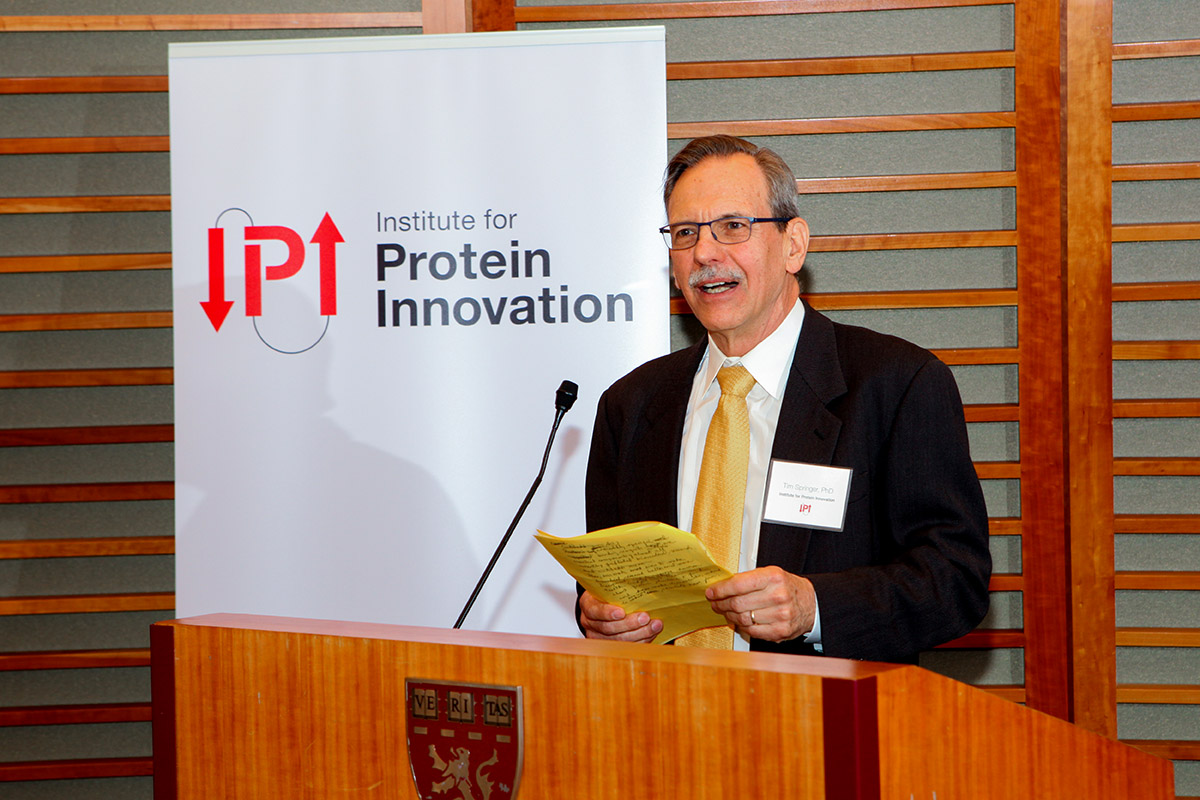Scientist, entrepreneur and philanthropist Timothy Springer is one of three scientists to win the 2022 Albert Lasker Award for Basic Medical Research, widely regarded as America’s top biomedical research prize.
The Latham Family Professor of Biological Chemistry and Molecular Pharmacology in the Blavatnik Institute at Harvard Medical School and Boston Children’s Hospital, Springer is recognized alongside Richard Hynes of the Massachusetts Institute of Technology and Erkki Ruoslahti of the Sanford Burnham Prebys Medical Discovery Institute.
When their research unexpectedly converged in the 1980s, Springer, Hynes and Ruoslahti discovered integrins, a pivotal family of proteins embedded in the membrane of nearly every cell in the human body, providing an essential link to their surroundings. The discovery paved the way for a new class of therapeutics to treat a range of conditions including some autoimmune diseases and cancers.
That chapter of Springer’s work relied on antibodies and would lead him to co-found the Institute for Protein Innovation (IPI) in 2017. Now, the Institute embodies his long-held desire to go beyond the limits of traditional antibodies to accelerate the work of biological scientists and thereby improve human health.
“IPI is my legacy project,” Springer told In Vivo. “It encapsulates, in a practical, integrative way, all that I have accomplished in researching the functions and interactions of biomedically important proteins to create treatment advances in immunology, hematology, infectious disease and cancer.”
Early idealism
Springer is not a typical academic scientist. Early on, he attended Yale University but left after a year to pursue more altruistic ideals. He spent a year with the domestic Peace Corps program, VISTA, serving on a Shoshone reservation in Nevada. That experience seeded a desire to do good in the world that he would later fulfill in more philanthropic pursuits.
He transferred to the University of California, Berkeley, where he earned his bachelor’s degree in biochemistry and first used antibodies in independent research. Springer next earned a Ph.D. in biochemistry from Harvard University, working under the guidance of immunologist Jack Strominger on proteins residing on the surface of immune cells.
His work continued as a postdoctoral student with César Milstein in Cambridge, England. Milstein personally taught Springer how to make monoclonal antibodies, made possible by a technique Milstein invented that later won him and Georges Köhler the Nobel Prize in Physiology or Medicine. This would be the inspiration for Springer to launch IPI 40 years later.
Scientific success
After studying briefly under Milstein, Springer returned to Harvard in 1977 as an assistant professor at Harvard Medical School. There, he used monoclonal antibodies to discover cell surface-based molecules that immune cells require to recognize and bind other cells, including the protein LFA-1. He then showed that LFA-1 was related to two other molecules on myeloid cells, Mac-1 and p150,95. Further, these three molecules were members of a family with one identical subunit, called beta, and distinct but related subunits, called alpha.
Unbeknownst to Springer, Hynes and Ruoslahti had independently identified and sequenced fibronectin. As a result, they uncovered a cell surface protein, glycoprotein IIb/IIIa, that helps affix cells to the surrounding material, or the extracellular matrix.
These initially disparate lines of inquiry converged and expanded after all three investigators realized that the proteins belong to the same molecular family, the discovery now marked by the trio’s Lasker Award.
Named integrins partly for the integral role its members play in connecting cells to their surroundings, the proteins offered scientists a common point of intervention to develop therapeutics for a range of diseases. For example, Springer and others found that a group of individuals with leukocyte adhesion deficiency, marked by recurrent life-threatening bacterial infections, bear mutations in the shared beta subunit of LFA-1, Mac-1 and p150,95.
Continuing this high-discovery pace, Springer’s lab in 1991 elucidated a three-step process by which white blood cells traffic from the bloodstream to tissues to find and fight infections. The work won him and Eugene Butcher the 2004 Royal Swedish Academy of Sciences’ Crafoord Prize. In 2019, those findings and his ability to translate them into clinical impacts also earned Springer Canada’s Gairdner Award, nicknamed “Canada’s Nobel.” Since 1996, Springer has been a member of the National Academy of Sciences.
Clinical impact
Despite the tremendous scientific success, Springer felt he could do more. His lab had shown that each of three steps in the immune cell trafficking process required a unique receptor and receptor partner, called a ligand, for each type of white blood cell involved. The combination of the steps in this process, like the digits in an area code, encoded the type of cell that left the bloodstream and the location in the body to which it trafficked.
By extension, each receptor and ligand represented a target for drug discovery. Theoretically, an inhibitor to any molecular player in this three-step process could enhance the flow of a specific immune cell type to sites of pathogen invasion or block it during autoimmune disease.
To go after this plethora of potential targets, Springer founded his first company, LeukoSite, in 1992. In the mid-1990s, one promising monoclonal antibody inhibitor entered preclinical trials, resulting in the blockbuster drug vedolizumab, known commercially as Entyvio. This humanized monoclonal antibody selectively thwarts an integrin that promotes immune cell migration into the gut, thereby ameliorating ulcerative colitis and Crohn’s disease. The agent was approved by the Food and Drug Administration for both conditions in 2014. Since then, more than 100 integrin-targeted therapies have entered clinical trials or been approved by the FDA, including interventions for autoimmune diseases, endometriosis, and carcinoma and other cancers.
Entrepreneurship and philanthropy
In 1999, Millennium Pharmaceuticals, now owned by Takeda Pharmaceutical Company, acquired LeukoSite for stock that later appreciated to $3 billion. Thinking he could never successfully develop another company of that stature, Springer devoted his time to his research laboratory. But, in 2008, his interest in biotech was rekindled. Since then, while remaining a full-time academic, Springer has invested in three companies and founded and invested in another four, including Moderna Therapeutics and Scholar Rock, the latter attempting to generate therapeutic antibodies to cell surface receptors.
While successful thus far, Springer still recognized the limitations of using monoclonal technologies, particularly that they fail to produce antibodies against identical –– and even similar –– molecules between humans and mice.
He began to read and hear around his scientific circles about a technology where one could generate antibodies synthetically using genetically engineered yeast. The technique mimics what happens in the human body when it encounters a microbe and needs to generate an antibody defense. Excited, he teamed up with Andrew Kruse, then a rising star at Harvard and now a professor there, who specialized in making libraries of these yeast display synthetic antibodies.
The two launched IPI in 2017 as a nonprofit venture to create a means for basic research scientists to access antibodies directed against membrane and secreted proteins, the key targets for most successful drugs.

“There are all these molecules on cell surfaces and outside cells, and many of them can’t be identified with traditional antibodies,” Springer said in 2017. “We want to put these antibodies in the hands of investigators to make new discoveries.”
IPI is now developing high-throughput methods that leverage yeast display and other technologies to generate high-quality antibodies for challenging protein targets, particularly in neuroscience and developmental biology. Unlike most commercial entities, IPI scientists also characterize those antibodies to determine their fitness for purpose before distribution in an open science model. The work and the distribution model will provide reliable antibodies to the scientific community, bolster research initiatives and inspire new treatments in the clinic.
“IPI is my legacy project,” Springer said. “It encapsulates, in a practical, integrative way, all that I have accomplished in researching the functions and interactions of biomedically important proteins to create treatment advances in immunology, hematology, infectious disease and cancer.”
Learn more about integrins.
Learn more about Springer.
Are you a journalist? Find our media kit here.
Writers: Trisha Gura, trisha.gura@proteininnovation.org;
Halle Marchese, halle.marchese@proteininnovation.org


